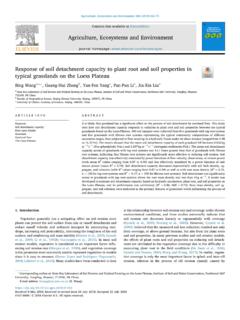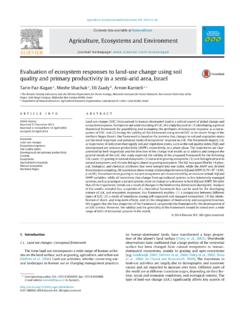Transcription of Agriculture, Ecosystems and Environment
1 Contents lists available atScienceDirectAgriculture, Ecosystems and Environmentjournal timing regulates extreme drought impacts on CO2and H2 Oexchanges over semiarid steppes in Inner Mongolia, ChinaYanbin Haoa, , Hui Zhangb,1, Joel A. Biedermanc, Linfeng Lia, Xiaoyong Cuia, Kai Xued,Jianqing Dua, Yanfen WangaaCollege of Life Sciences, University of Chinese Academy of Sciences, Beijing 100049, ChinabCollege of Bioscience and Biotechnology, Yangzhou University, Yangzhou 225009, ChinacSouthwest Watershed Research Center, Agricultural Research Service, Tucson, AZ 85719, USAdCollege of Resources and Environment , University of Chinese Academy of Sciences, Beijing 100049, ChinaARTICLE INFOK eywords.
2 GrasslandsNet ecosystem CO2exchangeGross primary productivityEcosystem respirationWater use efficiencyClimate changeExtreme drought timingABSTRACTC limate models predict a substantial increase in the frequency of extreme drought, suggesting subsequent im-pacts on the carbon (C) and water cycles. Although many studies have investigated the impacts of extremedrought on ecosystem functioning, it remains unknown how the timing of extreme drought within a growingseason may affect carbon and water cycling. Here we conducted a 3-yearfield experiment to investigate theinfluence of seasonal drought timing on ecosystem carbon and water exchange by excluding rainfall (for con-secutive 30 days) during three periods of the growing season (May June, July August and August September) infenced and grazed sites of a semiarid temperate steppe in Inner Mongolia, China.
3 In the fenced steppe, extremedrought reduced growing-season net CO2uptake regardless of drought timing, while in the grazed steppe, early-growing season drought caused relatively larger reductions to net CO2uptake than drought imposed later in theseason. The effect of extreme drought on evapotranspiration (ET) was similar to that of CO2exchange at thefenced site, with consistent reductions of seasonally-integrated ET for all treatments compared with the ambientcondition. In contrast, at the grazed site, the response of ET to extreme drought was more variable, possibly dueto the absence of litter and greater bare ground.
4 Surprisingly, both gross and net carbon uptake declined withincreasing ET at the grazed site, while the fenced site showed the positive water-carbon linkage typically seen insemiarid Ecosystems . The different responses of CO2and water exchanges for the fenced and grazed sites wereregulated predominately by soil temperature and soil water content. Together, our results show that droughttiming within the growing season can significantly alter drought impacts on ecosystem water and CO2ex-changes, and that grazing management may further mediate the IntroductionMounting evidence suggests that extreme drought events will es-calate in intensity and frequency throughout this century as precipita-tion variability increases under global warming (De Boeck et al.)
5 , 2010;Denton et al., 2017). When drought regimes are considered from anecological perspective, it is becoming increasingly apparent that sea-sonal timing of drought is also crucial for determining the terrestrialcarbon (C) cycle and its feedback to global climate change (De Boecket al., 2010; Wolf et al., 2016;Zeiter et al., 2016). Extreme droughtevents can occur at different temporal scales, inter- and intra-annual,triggering potential variation in biophysical variables (such as plant,soil water etc.) and altering CO2exchange between the land and theatmosphere (Dietrich and Smith, 2016; Zeiter et al.
6 , 2016;Denton et al.,2017). Many studies have shown that extreme drought events, occur-ring in a variety of seasons, have profoundly influenced plant growthand functioning. However, the ecological implications of greater intra-season variability of precipitation extremes have received minimalnotice, especially concerning variable timing of drought within thegrowing season, which should have the largest ecological consequences(Knapp et al., 2008; Fern ndez et al., 2014;Dietrich and Smith, 2016).The effects of seasonal timing of drought on ecosystem C cycling arepoorly understood.
7 Ecosystem CO2exchange and storage can be alteredby shifting of net ecosystem exchange of CO2(NEE), which 13 March 2018; Received in revised form 12 June 2018; Accepted 17 June 2018 Corresponding author contributed equally to this Hao). agriculture , Ecosystems and Environment 266 (2018) 153 166 Available online 16 August 20180167-8809/ 2018 Elsevier All rights by the difference between C sequestration through grossprimary productivity (GPP) and release through ecosystem respiration(RE). Some studies of naturally occurring drought have shown thatecosystem CO2exchange is sensitive to the temporal variability ofdrought within the year (Wolf et al.
8 , 2016;Zeiter et al., 2016). Droughtsarising at different stages of the growing season are expected to havedifferent effects on ecosystem CO2exchange. We can argue that ifdroughts occur during sensitive periods for vegetation growth, seasonalecosystem photosynthesis will decrease more strongly. For example,under severe drought conditions, high evaporative demand, coupledwith limited plant canopy development during the early-growingseason, could constrain transpiration and CO2assimilation. Further-more, early-season drought may alter vegetation structure such that theecosystem requires a long recovery period, even after water stress isalleviated (Jongen et al.
9 , 2011). Because vegetation is likely to havedeveloped prior to a mid-growing season drought (DM), we expectplants to better tolerate and to recover more quickly from DM (Parueloand Lauenroth, 1995; Briggs and Knapp, 2001). In the late-growingseason, plants approach senescence and become less sensitive to waterstress, reducing drought effects on photosynthesis (Dietrich and Smith,2016). Despite the potential importance of drought timing as a de-terminant of ecosystem CO2exchange, it remains unclear how extremedroughts occurring at different growing stages affect C, due to a lack ofexperimental studies under manipulated (ET), which comprises plant transpiration (T)and evaporation (E) from wet canopy and soils, is an important com-ponent of ecosystem water cycling.
10 In water-limited Ecosystems , ET isalso a good proxy for soil water to drive ecosystem CO2exchange afterhydrologic losses (Biederman et al., 2016, 2018; Jia et al., 2016. Ex-treme drought can affect ET through altering transpiration and et al. (2015)found that extreme drought suppressedboth E and T due to reduced soil water availability. Therefore, seasonaltiming of drought may affect ET indirectly by reducing vegetation ca-pacity for transpiration and increasing the fraction of bare ground(Denton et al., 2017) or directly by limiting soil moisture, which sup-plies both E and T.)











